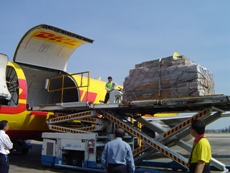Trade uncertainties, security issues and raw material shortages are major risks to international supply chains this year, according to a new DHL Resilience360 report.
These follow on from diverse events which affected worldwide logistics flows last year, including climate-driven shipping disruptions, higher than expected cyber-attacks targeting supply chain assets, and industry zone shutdowns impacting production activities.
These were some of the main findings of the first-ever annual Risk Report from DHL Resilience360, based on risk and incident data collected by DHL’s cloud-based risk management provider.
In a rapidly evolving supply chain risk environment, successful risk assessment is a significant challenge for companies in all sectors, DHL pointed out. The Resilience360 Annual Risk Report is based on the experience and insights of in-house analysts, who monitor hundreds of risk events each day. DHL’s experts help companies proactively manage disruptive events, from political violence to cargo theft, and minimize business interruption.
“The Resilience360 Annual Risk Report sums up our expertise to our customer’s benefit in a very comprehensive way. Risk assessment and building up supply chain resilience is a crucial part of our customers’ business. Wherever they operate, the report’s insights will make the re-evaluation of the respective risk environment easier and thus complement the existing Resilience360 offer,” explained Tobias Larsson, CEO Resilience360.
The first Resilience360 Annual Risk Report examined the major supply chain risks that companies experienced in 2018. The world’s top three risks were uncertainties concerning trade flows, cyber security incidents, and climate change paired with extreme weather conditions, it found.
Uncertainty in trade increased due to disputes between the US and other countries, in particular China, including new unilateral import tariffs. The still-open question of the UK’s withdrawal from the EU is also contributing to uncertainty, as companies fear border congestions and delays at ports in the event of a disorderly departure.
In the realm of cyber security, a rising number of incidents involving supply chain and transport infrastructure showed how actors are intent on obtaining trade secrets, engaging in blackmail, or causing economic disruption. Lastly, climate change presented a myriad of severe weather-related disruptions in 2018, which was the 4th warmest year on record. Wildfires, droughts, low water levels and melting ice had the most significant impacts on supply chains.
In Europe, two-thirds of high-impact events were caused by cargo theft, industrial fires and explosions, and train accidents. But civil unrest, including the Yellow Vest protests in France and Belgium, disrupted highways, ports, border crossings and access roads to industrial areas.
Weather events also posed problems for supply chains. A month-long drought in summer and autumn resulted in record-low levels of water on the Rhine River. The water levels inhibited shipping traffic, and chemical and steel makers in Germany, France and the Netherlands were compelled to declare force majeure on deliveries. Natural disasters affected countries across Europe as well. In October, Greece was struck by an earthquake near Zakynthos Island, while Italy, Spain, France, and the United Kingdom experienced heavy floods.
Looking ahead to this year, the Risk Report highlighted an array of threats that may become particularly salient for businesses in 2019 and beyond. In addition to ongoing global risks like the international tensions that characterized trade in 2018, companies may also face additional costs and uncertainty due to raw material shortages, recalls and safety scares or tougher environmental regulations.
Firstly, rising demand for raw materials, coupled with a fragile supply caused by political instability and supplier shutdowns, may result in raw material shortages for crucial materials such as lithium, cobalt, and adiponitrile. Second, recalls and safety scares may increase, as wider public awareness of quality issues and stricter enforcement by regulators in highly regulated sectors such as pharmaceuticals and medical devices subject products to higher scrutiny.
Lastly, anti-pollution measures may be expanded in 2019 to a broader range of industries across Asia. The US Environmental Protection Agency is also expected to announce new requirements. As a result, tougher environmental regulations will increase costs for businesses in a number of industries. All of these developments have the potential to put suppliers under threat and force significant changes throughout supply chains.
“Modern supply chains are vulnerable. Transportation delays, theft, natural disasters, inclement weather, cyber-attacks and unexpected quality issues can disrupt cargo flows, creating short term costs and delivery challenges,” added Shehrina Kamal, Director Risk Intelligence, Resilience360. “Resilience360 strives to understand these risks and gain a common understanding of how they impact supply chains across countries, regions, industries and organizations in measurable ways.”
The full report, with detailed findings from 2018 and an overview of the coming challenges in 2019, can be downloaded at www.resilience360.dhl.com.












